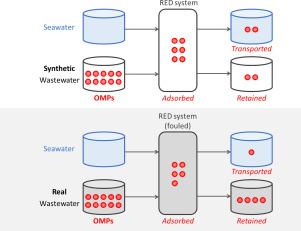Desalination ( IF 8.3 ) Pub Date : 2021-05-05 , DOI: 10.1016/j.desal.2021.115114 Lingshan Ma , Leonardo Gutierrez , Tom Van Vooren , Marjolein Vanoppen , Mohammad Kazemabad , Arne Verliefde , Emile Cornelissen

|
Reverse electrodialysis (RED)-based hybrid processes (e.g., RED-ED/RO) have been proposed for more energy-efficient desalination in drinking water production. The use of secondary-treated wastewater as a low-salinity stream in RED raises concerns about enhanced membrane fouling and, especially, potential organic micropollutants (OMPs) contamination of drinking water sources. The influence of membrane fouling and channel clogging on the transport and adsorption of 25 OMPs in RED was investigated using synthetic and real seawater and secondary-treated wastewater for 40 days. Real wastewater induced more membrane fouling and channel clogging than its synthetic counterparts and real seawater, as evidenced by pressure drop increase, permselectivity decrease, and ATP levels increase. The OMP transport and adsorption in real seawater conditions were higher than their synthetic counterparts, while OMP transport and adsorption under real wastewater conditions decreased significantly compared to synthetic wastewater conditions, possibly due to: 1) higher OMP-membrane interaction compared to OMP-fouling layer interaction (steric and electrostatic mechanisms), and 2) OMP adsorption onto the effluent organic matter in real wastewater. These results provide critical implications for industrial scenarios: OMPs transport might be overestimated at the lab-scale when using synthetic streams, clearly indicating the key role of effluent organic matter and fouling in RED using impaired water.
中文翻译:

反向电渗析中有机微量污染物的命运:膜污染和通道堵塞的影响
已经提出了基于反向电渗析(RED)的混合工艺(例如RED-ED / RO),以提高饮用水生产中的能源利用效率。在RED中将二次处理的废水用作低盐度废水引起了人们对膜污染增加的担忧,尤其是对饮用水源的潜在有机微污染物(OMPs)污染的担忧。使用合成的和实际的海水以及二次处理的废水,研究了膜污染和通道堵塞对RED中25种OMPs迁移和吸附的影响,处理了40天。实际废水比合成人工废水和实际海水引起更多的膜污染和通道堵塞,这可通过压降增加,渗透选择性降低和ATP含量增加来证明。实际海水条件下的OMP运移和吸附高于合成海水中的OMP,而实际废水条件下的OMP运移和吸附相较于合成废水条件则显着下降,这可能是由于:1)与OMP结垢层相比,OMP-膜之间的相互作用更高相互作用(空间和静电机制),以及2)OMP吸附到实际废水中的流出有机物上。这些结果为工业场景提供了关键的含义:当使用合成物流时,在实验室范围内OMPs的运输可能被高估了,这清楚地表明了污水中有机物和RED在使用受损水的RED中的结垢的关键作用。而与合成废水相比,实际废水条件下的OMP迁移和吸附显着降低,可能是由于:1)与OMP-污垢层相互作用(空间和静电机理)相比,OMP-膜之间的相互作用更高; 2)OMP在废水上的吸附实际废水中的有机物。这些结果为工业场景提供了关键的含义:当使用合成物流时,在实验室范围内OMPs的运输可能被高估了,这清楚地表明了污水中有机物和RED在使用受损水的RED中的结垢的关键作用。而与合成废水相比,实际废水条件下的OMP迁移和吸附显着降低,可能是由于:1)与OMP-污垢层相互作用(空间和静电机理)相比,OMP-膜之间的相互作用更高; 2)OMP在废水上的吸附实际废水中的有机物。这些结果为工业场景提供了关键的含义:当使用合成物流时,在实验室范围内OMPs的运输可能被高估了,这清楚地表明了污水中有机物和RED在使用受损水的RED中的结垢的关键作用。











































 京公网安备 11010802027423号
京公网安备 11010802027423号